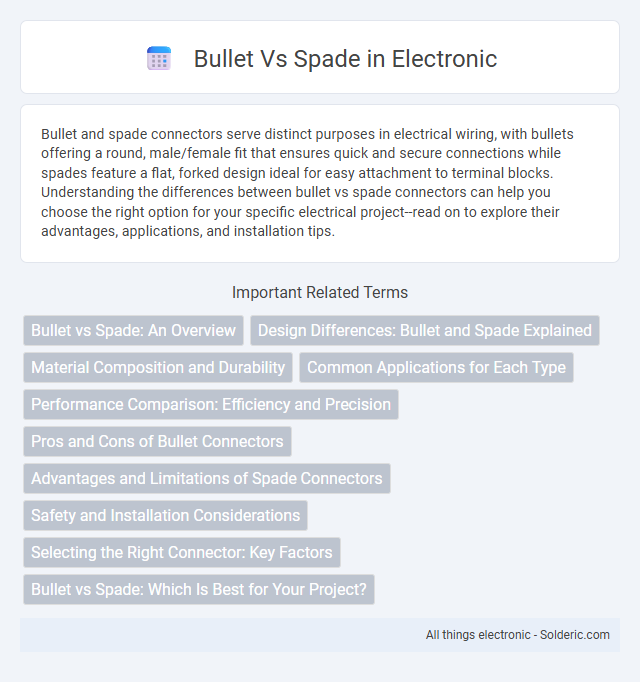Bullet and spade connectors serve distinct purposes in electrical wiring, with bullets offering a round, male/female fit that ensures quick and secure connections while spades feature a flat, forked design ideal for easy attachment to terminal blocks. Understanding the differences between bullet vs spade connectors can help you choose the right option for your specific electrical project--read on to explore their advantages, applications, and installation tips.
Comparison Table
| Feature | Bullet | Spade |
|---|---|---|
| Shape | Rounded, cylindrical projectile | Flat, pointed digging tool |
| Primary Use | Firearms ammunition | Gardening and digging |
| Material | Metal (lead, copper) | Metal blade with wooden or metal handle |
| Function | Penetration and impact | Soil cutting and lifting |
| Typical Sizes | Various calibers (e.g., 9mm, .45 ACP) | Blade width 6-12 inches, handle 3-5 feet |
| Industry | Weaponry, law enforcement, military | Agriculture, landscaping, gardening |
Bullet vs Spade: An Overview
Bullet and Spade are distinct types of excavation tools used in gardening and construction. Bullets feature pointed tips designed for precision digging and penetrating hard soil, while Spades have flat, rectangular blades ideal for cutting through sod and moving loose soil. Choosing between a Bullet and Spade depends on the specific task, soil type, and desired level of control during excavation.
Design Differences: Bullet and Spade Explained
Bullet and spade connectors differ primarily in shape and application, with bullet connectors featuring a cylindrical, male-female design for secure, easy connections often used in automotive wiring. Spade connectors have a flat, fork-like shape allowing quick attachment and removal on screw terminals or posts, commonly found in home appliances and industrial equipment. The bullet's rounded design reduces accidental disconnections, while the spade's open end facilitates rapid installation and maintenance.
Material Composition and Durability
Bullet points are often made from steel or brass, offering high durability and resistance to corrosion, making them ideal for long-term use in various applications. Spade tools typically feature forged steel blades with hardwood or fiberglass handles, designed to withstand heavy-duty digging and soil penetration without breaking. Your choice between bullet and spade depends on the specific material composition and durability requirements of your project.
Common Applications for Each Type
Bullets are commonly used in firearms ammunition for hunting, self-defense, and target shooting due to their aerodynamic shape and penetration capabilities. Spades are essential tools in gardening and landscaping, effective for digging, edging, and transplanting because of their flat, sharp blade that efficiently cuts through soil. Each tool's design caters to specific tasks where precision (bullets) or soil manipulation (spades) is required.
Performance Comparison: Efficiency and Precision
Bullet nails offer high efficiency with fast driving speeds and consistent holding power, making them suitable for large-scale construction projects. Spade nails provide superior precision in delicate woodworking tasks due to their flat, wide heads that reduce splitting and improve alignment. Your choice depends on balancing the need for rapid installation versus meticulous accuracy in project requirements.
Pros and Cons of Bullet Connectors
Bullet connectors offer quick and secure electrical connections with a simple push-and-pull design, making them ideal for automotive and motorcycle wiring. Their advantages include ease of installation, reliable conductivity, and resistance to vibration, which reduces the risk of disconnections. However, bullet connectors may be prone to corrosion in harsh environments and can sometimes loosen under extreme movement, posing potential reliability issues compared to spade connectors.
Advantages and Limitations of Spade Connectors
Spade connectors offer reliable, secure connections ideal for automotive and electrical applications, allowing easy installation and removal while ensuring stable contact. Their flat, fork-shaped design accommodates rapid termination and is compatible with screw-type terminals, though they may be less suited for high-vibration environments compared to bullet connectors. You benefit from improved maintenance access with spade connectors, but should consider limitations in sealing and potential for loosening under continuous movement.
Safety and Installation Considerations
Bullet anchors offer a quicker and easier installation process, ideal for lightweight applications and materials like drywall, but their holding strength may be limited compared to spade anchors. Spade anchors provide superior safety in heavy-duty tasks due to their enhanced grip and stability, making them suitable for securing heavier loads in masonry or concrete. For optimal safety and performance, ensure proper alignment and installation depth based on the specific anchor type and material characteristics tailored to your project.
Selecting the Right Connector: Key Factors
Choosing between bullet and spade connectors depends on factors such as ease of installation, space constraints, and electrical load requirements. Bullet connectors offer reliable, secure connections with simple push-fit assembly, making them ideal for wiring in tight spaces or where vibration resistance is crucial. Spade connectors provide flexibility for quick disconnection and reconnection, favored in automotive and electrical panel applications where frequent maintenance is expected.
Bullet vs Spade: Which Is Best for Your Project?
Bullet tools offer precision and efficiency for detailed tasks, making them ideal for intricate or small-scale projects. Spade tools provide powerful digging capabilities for heavy-duty soil removal and are better suited for large-scale landscaping or construction work. Choosing between bullet and spade depends on your specific project needs, with bullet tools favoring accuracy and spades excelling in raw strength.
Bullet vs Spade Infographic

 solderic.com
solderic.com